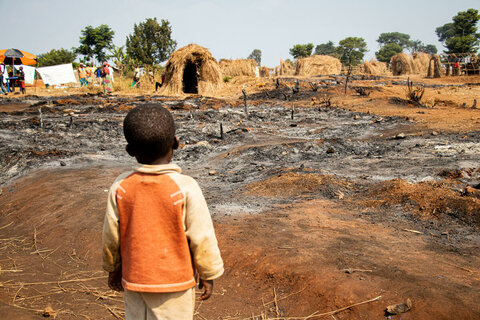Abandoned fields, soaring hunger: Gang violence hits Haiti's countryside

For his entire working life, Augustin has earned a living tilling the fertile land of Haiti’s central Artibonite department, the country’s breadbasket.
But when harvest time arrived last May, the 42-year-old rice farmer found bandits stealing his crop, their guns at the ready.
READ MORE: IPC data confirms record levels of hunger in Haiti
“I ran for my life,” recalls Augustin, whose last name is being withheld for his protection. The traumatic experience aggravated his diabetes, forcing doctors to amputate two fingers and a leg. Instead of helping to feed his country, Augustin and his family now count among its more than 362,000 conflict-displaced people.

“Today, I depend on others to survive,” says the father of five, whose family now shelters in a rural home a dozen kilometres away.
A massive humanitarian catastrophe risks engulfing Haiti, fuelled by spiralling violence and political instability. The fallout of the country’s worst armed uprising in decades spreads far beyond the capital Port-au-Prince, where armed gangs control much of the city, forcing thousands to flee.
Roadblocks have led to food and fuel shortages. Prices are skyrocketing. So is hunger. More than four in ten Haitians are acutely food insecure. Some 1.4 million people are one step away from famine.

Growers like Augustin cannot produce food their nation desperately needs, deepening the hunger crisis. Artibonite department alone has seen roughly 100 armed attacks over the past two years – the country’s second-highest number of such incidents after Port-au-Prince.
“Ensuring Haiti’s smallholder farmers can thrive is essential to its longer-term food security and stability,” says World Food Programme (WFP) Haiti Country Director Jean-Martin Bauer. “Without guaranteeing Haitians have enough to eat – not just today, but also tomorrow – this country will never find peace.”
Shrinking production
WFP analysis using European Space Agency satellite imagery found up to 3,000 hectares of Artibonite’s farmland was abandoned in 2023, compared to 2018. Our findings also show hunger skyrocketed in these areas, jumping from 40 percent to 57 percent in the past year alone.
“Conflict and hunger are closely linked,” says Laure Boudinaud, Vulnerability Analysis and Mapping Officer for WFP in Haiti. “In an essentially agricultural country like Haiti, when production zones are abandoned, the population suffers one way or another.”

The situation isn’t entirely bleak. In safer parts of Artibonite, where thousands of conflict-displaced families have found refuge, satellite imagery has detected new plots of cultivated land. Our findings show food insufficiency in these areas has shrunk by nearly one-fifth.
But it is not enough. “Needs are high,” WFP’s Bauer says. “We need security, we need access, we need the shooting to stop.” With vital food cargo blocked from entering the country, WFP’s own supplies are running dangerously low.
WFP first began using satellite imagery to analyze conflict’s effect on farming in Mali. It was later replicated in other African Sahel countries facing similar issues of unrest and restricted humanitarian access. Last year, the technique was rolled out in Haiti as well.
“Our mapping explicitly shows how rising insecurity has affected Haiti’s most important breadbasket during last year’s main farming season,” says WFP vulnerability analyst Boudinaud. “The correlation between abandoned farm fields and the presence of armed groups and violence is clearly evident.”

For Haiti’s farmers, the spiking violence adds to a raft of other challenges. Climate change has unleashed both floods and punishing droughts in recent years. The surge of displaced people from the capital has increased food needs in rural areas that now shelter them.
After his encounter with the bandits, Augustin escaped with his family by foot, walking more than two hours to safety. He was already on crutches because of his diabetes. Today, he is destitute.
“I still owe the bank 20,000 gourdes (about US$150), even as the bandits harvested my crop,” he said.
The payoffs of peace
During more stable times, WFP worked with rural communities to rehabilitate roads and irrigation canals, conserve soil and water, and reinforce local food production. Last year alone, and despite rising violence, we teamed up with the government and partners to purchase US$8.4 million in local produce – a regional record.

Nearly one-fifth of that food has been cooked up into WFP-supported school meals. That share is expected to grow sharply, if stability takes hold. Indeed, WFP aims to source all its school meals from local farmers as early as 2028, in line with Government objectives.
“This is my greatest pride,” says banana-producer Iler Cambronne, from the northern Haitian commune of Gonaives, whose produce has contributed to the school feeding programme. “I feel enormous satisfaction when I realize that it's my plantains that the children eat at school.”

Today, however, unrest has shuttered many Haitian schools, depriving tens of thousands of young pupils not only of nourishing meals, but of an education. It has also shattered the lives of millions of Haitians like Augustin.
“The people Haiti deserve better than the chronic instability, poverty and hunger that they been exposed to,” says WFP Country Director Bauer. “There's a problem here that's been unaddressed for years. Now, it’s blowing up in our faces.”


